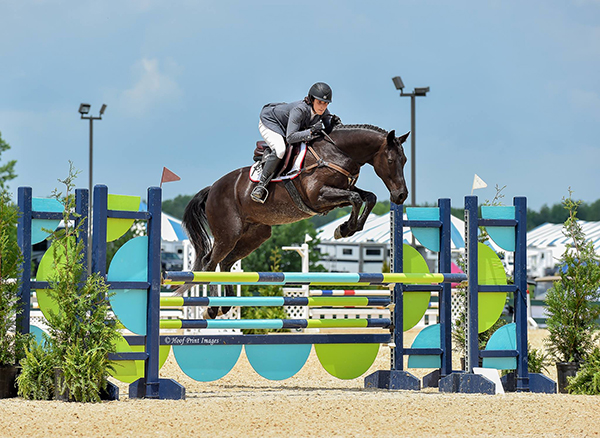The Allure of Competing Without a Bridle
A few months ago, we shared a video on our The Equine Chronicle FB page of a rider competing in Bridleless Trail. It was viewed 157,000 times. What is it about the concept of riding a horse without a bridle that garners such attention? Is it the admiration of such a deep connection between partners that physical restraint seems unnecessary?
While events like Bridleless Reining and Bridleless Trail have gained in popularity, it doesn’t seem the appeal has transferred over into English disciplines. Until now.
Meet Melanie Ferrio-Wise and her horse, Vlad. They’re currently the only pair consistently competing bridleless on the USEF rated jumpers circuit. They made history when they were the first pair to compete at the Washington International Horse Show without a bridle. But what this team is doing is a bit different than the speciality bridleless classes you may see at a weekend horse show. Melanie and Vlad compete in regular classes, without a bridle, against horses wearing bridles.
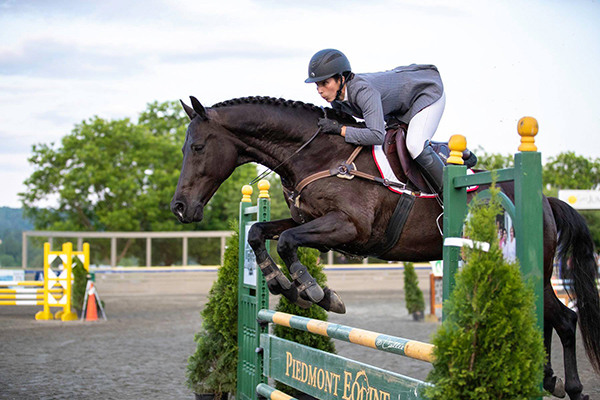 “There are people who ride bridleless, and there are a few who do it at shows, but we’re currently the only bridleless pair showing on the USEF rated circuit. I’m competing in regular classes with regular bridled horses. These are the same people I showed against before I decided to go unbridled. There are currently no rules against showing bridleless. In fact, we also showed at HITS Culpeper, bareback and bridleless. This was just for fun, and we don’t plan to show that way on a consistent basis. With that being said, there are no rules against this. Show management has the last say about showing unbridled. I always email and ask the show management before I show up and expect to compete without a bridle.”
“There are people who ride bridleless, and there are a few who do it at shows, but we’re currently the only bridleless pair showing on the USEF rated circuit. I’m competing in regular classes with regular bridled horses. These are the same people I showed against before I decided to go unbridled. There are currently no rules against showing bridleless. In fact, we also showed at HITS Culpeper, bareback and bridleless. This was just for fun, and we don’t plan to show that way on a consistent basis. With that being said, there are no rules against this. Show management has the last say about showing unbridled. I always email and ask the show management before I show up and expect to compete without a bridle.”
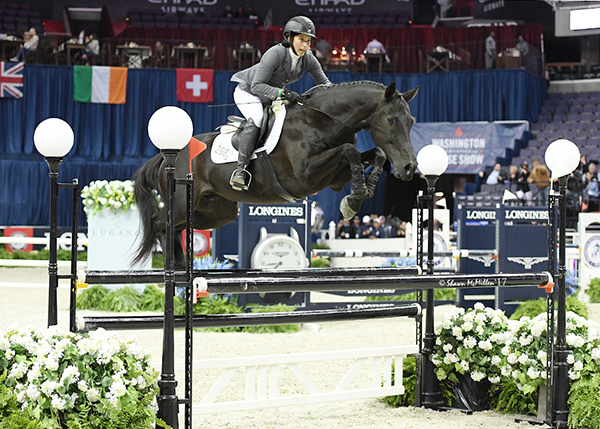 Melanie and Vlad have been a team since 2016. Vlad came to Melanie and her husband, Brendan Wise, from the Dominican Republic with a troubled past. “He was struggling with show horse life. He has always been a tense, nervous horse and, sadly, he always let his emotions get the best of him. He was imported from the Dominican Republic when he was nine years old. For his whole life, he has been a difficult ride. Vlad came to the US as a Dressage prospect, but he was proving to be very hard to handle. He was given to my husband and I in hopes we could help him. After a long two years, he was slowly coming back under saddle. We quickly found a love for show jumping and off we went making waves on the show jumping circuit, eventually becoming the only bridleless pair consistently showing on the USEF rated circuit.”
Melanie and Vlad have been a team since 2016. Vlad came to Melanie and her husband, Brendan Wise, from the Dominican Republic with a troubled past. “He was struggling with show horse life. He has always been a tense, nervous horse and, sadly, he always let his emotions get the best of him. He was imported from the Dominican Republic when he was nine years old. For his whole life, he has been a difficult ride. Vlad came to the US as a Dressage prospect, but he was proving to be very hard to handle. He was given to my husband and I in hopes we could help him. After a long two years, he was slowly coming back under saddle. We quickly found a love for show jumping and off we went making waves on the show jumping circuit, eventually becoming the only bridleless pair consistently showing on the USEF rated circuit.”
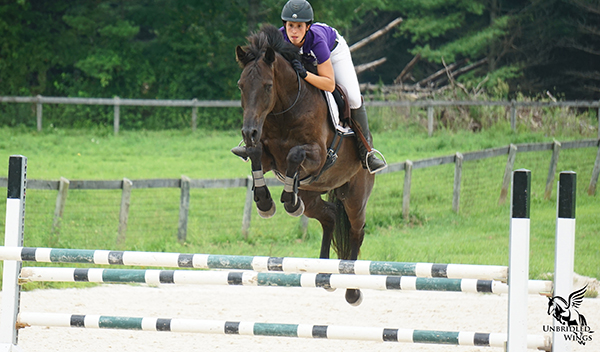 Let’s back up for a second. “Troubled” and “bridleless” aren’t two adjectives you’d expect to see being used to describe one horse. Prior to Vlad, Melanie had another horse that she trained and rode bridleless on a daily basis, so she already had a love for riding in this manner. At first, she didn’t even consider that Vlad would be a candidate for this type of training. But she decided to try…
Let’s back up for a second. “Troubled” and “bridleless” aren’t two adjectives you’d expect to see being used to describe one horse. Prior to Vlad, Melanie had another horse that she trained and rode bridleless on a daily basis, so she already had a love for riding in this manner. At first, she didn’t even consider that Vlad would be a candidate for this type of training. But she decided to try…
“On occasion, I would take off the bridle to see what he thought of it. It was always the same result. He was almost always strong and fast. This was him MO most of the time, even in the bridle. Of course, this was not an easy change. The most difficult challenge was the fact that Vlad was very forward, and he doesn’t handle being confused. If he was confused or frustrated about the learning process, he would just speed up. That’s not a good trait for a bridleless horse! As we started to learn and progress as a team, we learned a new language together. Giving him the freedom to make the correct answer, without force, was helping him think through the learning process of daily riding. He was truly starting to relax and work with me, not against me!”
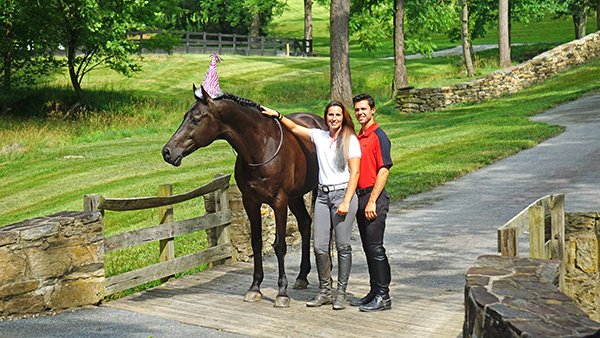 Melanie quickly discovered that her once fiery and tense jumper was now a relaxed, push ride. “I was amazed and of course I was loving the change! Preparing a bridleless horse is generally pretty easy. It’s a long process, but easy. I find that most horses can pick it up very quickly. When starting to think about bridleless, you want to make sure your horse understands leg and seat cues very well in the bridle first. This is the foundation of everything you do bridleless. If you don’t have it before taking the bridle off, the rider will have trouble setting the tone for the bridleless ride.”
Melanie quickly discovered that her once fiery and tense jumper was now a relaxed, push ride. “I was amazed and of course I was loving the change! Preparing a bridleless horse is generally pretty easy. It’s a long process, but easy. I find that most horses can pick it up very quickly. When starting to think about bridleless, you want to make sure your horse understands leg and seat cues very well in the bridle first. This is the foundation of everything you do bridleless. If you don’t have it before taking the bridle off, the rider will have trouble setting the tone for the bridleless ride.”
“I think the biggest exercises we do involve a lot of forward to back transitions and lots of figure of eights so that we’re always working on bending with the horse. This allows you to work on bend and responding to the leg in one exercise. If you can bend, back up, and move off the leg, everything will come very quickly!”
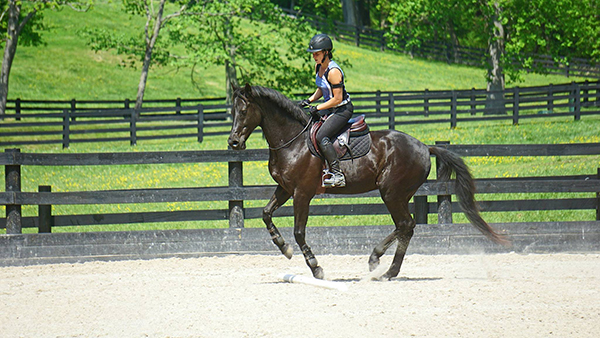 Still, Melanie explains that teaching a horse to compete without a bridle isn’t something that can be accomplished in a few hours. “My husband and I have higher expectations for our bridleless horses. We want our bridleless horses to go around just as well balanced as horses in the bridle. Better even.”
Still, Melanie explains that teaching a horse to compete without a bridle isn’t something that can be accomplished in a few hours. “My husband and I have higher expectations for our bridleless horses. We want our bridleless horses to go around just as well balanced as horses in the bridle. Better even.”
Now, Vlad is a full time bridleless horse. He’s only been ridden in the bridle twice since he made his bridleless debut back in October of 2017 at the Washington International Horse Show. Melanie and Vlad currently compete in High Adult Jumpers classes that run from 1.10m-1.15m. As of October 1st, Vlad received an invitation to compete at the 2018 Washington International Horse Show, October 23-28.
Despite finding a method of training and showing that has transformed her relationship with her horse, Melanie does occasionally meet with some naysayers. “Honestly, most people are fascinated by it; but, of course, there are a few people that feel it’s unsafe or stupid. I’ve learned to ignore them and go about my day. At first, it made me feel like if I didn’t do perfect, then they would complain, and that was hard to overcome. But, I think about it like this: how many people fall, have stops, rails down, or just in general not perfect rounds, with a bridle, at a show? Vlad is generally more controlled and goes around quieter than most jumpers in the ring. Does this mean I always have perfect rounds? No way, but we sure do try our best. If something doesn’t go well, I assess the problem and fix it. The people that have a problem with the way that I ride are the people who don’t understand it or haven’t seen my horse go in the bridle. Could it be dangerous? Of course! But, that’s the beauty of it. Vlad was a challenging horse that has made a 100% turn around, and I trust him with my life.”
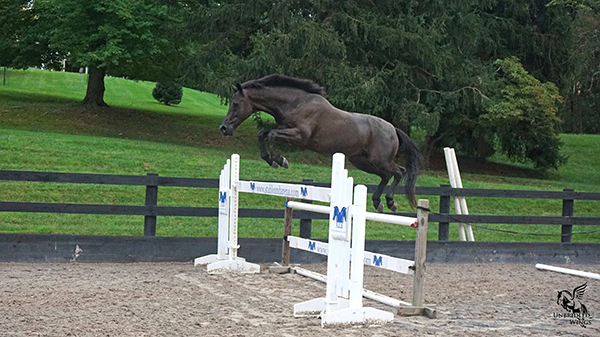 Melanie does admit that sometimes she gets nervous, but it’s not because she’s riding bridleless. “I think the opposite actually. Riding bridleless gives Vlad the freedom to jump how it’s natural for him. He’s able to use his body and move the way he feels that he needs to in order to get over the fence. Needing to have contact on the mouth is not a necessity to jump a horse that loves to jump. My record with Vlad is 5’3″. I was nervous, yes, but I wasn’t nervous that I was bareback and bridleless. I was nervous because that fence was huge riding up to it! I knew he would get me to the other side. I just had to let him do his job. I think too many times we actually get in our horses’ way. Riding bridleless to a fence is no different then riding with a bridle, if you have prepped your horse well to do so.”
Melanie does admit that sometimes she gets nervous, but it’s not because she’s riding bridleless. “I think the opposite actually. Riding bridleless gives Vlad the freedom to jump how it’s natural for him. He’s able to use his body and move the way he feels that he needs to in order to get over the fence. Needing to have contact on the mouth is not a necessity to jump a horse that loves to jump. My record with Vlad is 5’3″. I was nervous, yes, but I wasn’t nervous that I was bareback and bridleless. I was nervous because that fence was huge riding up to it! I knew he would get me to the other side. I just had to let him do his job. I think too many times we actually get in our horses’ way. Riding bridleless to a fence is no different then riding with a bridle, if you have prepped your horse well to do so.”
To keep up with Vlad and Melanie’s journey, visit https://www.facebook.com/UnbridledWings/










